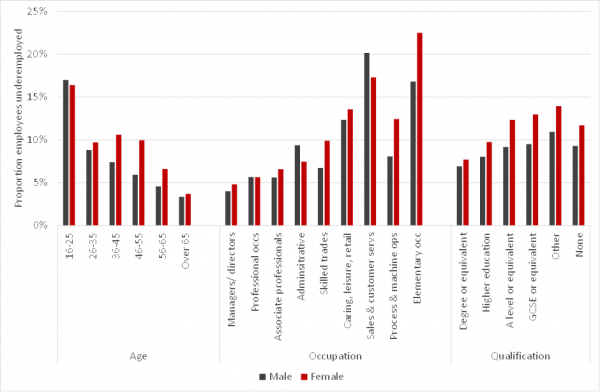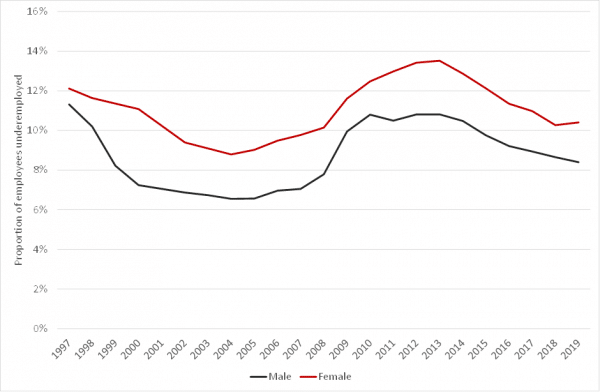Our previous blog summarised patterns in weekly hours worked and how those are changing over time. In the second of our articles summarising key points from our interim report, this blog considers the extent to which workers are satisfied with their working hours, and goes on to consider issues around job and hours insecurity.
Underemployment is associated with higher rates of depression and unhappiness
Analysing patterns of hours worked or changes in those patterns over time does not in itself tell us anything about how satisfied workers are with those hours. Economic theory would predict that workers choose how many hours to work based on their preferences for income relative to leisure (or non-work) time. In this sense, the observation that one group is working fewer hours than another, or fewer hours than it used to, is not necessarily a cause for concern. Arguably, policy-makers should only be concerned about the welfare implications of hours where hours worked diverge significantly from desired hours.
Underemployment is measured by asking those in employment how their desired hours differ from their usual hours of work. Specifically, workers are asked whether they would like to work longer hours at their current basic rate of pay, given the opportunity.
The underemployed are more likely to suffer from depression, and are more likely to be anxious and unhappy, compared to workers who are not underemployed – although this does not mean the relationship is necessarily causal.
The underemployed are more likely to be young, less qualified, and low-paid
Consistent with others’ findings, we find that the underemployed are more likely to be young, working in low-paid jobs, and less well qualified (Chart 1).
Chart 1: Underemployment is highest amongst the young and those working in low-paid occupations
Proportion of male and female employees who would work longer hours at current wage if given the opportunity, by age, occupation and highest qualification (2019)
Source: FAI analysis of LFS
Underemployment is a proxy for dissatisfaction with pay and income
Looking over time, the proportion of workers who are underemployed is not correlated in any way with changes in hours worked. Instead, the rate of underemployment seems to be driven by changes in real net income. The underemployment rate increased substantially in 2009/10 and increased to 2013/14, coinciding with falling real pay and household incomes but largely unchanging patterns of hours worked. Since 2014, underemployment has been falling gradually, coinciding with weak growth in real pay (Chart 2).
This suggests that underemployment is really a proxy for a more general dissatisfaction with the level of income from work – or the security of that income.
In the next phase of the project we plan to investigate in more detail the relationship between household net incomes, poverty and underemployment.
Chart 2: Underemployment increased following the financial crisis
Proportion of male and female employees who would work longer hours at current wage if given the opportunity
Source: FAI analysis of LFS
Precarious forms of employment can affect health and wellbeing, but identifying how much insecurity is increasing is difficult
So far, we have simply considered hours worked. But the regularity and predictability of hours matter too. There has been much commentary and concern in recent years about the apparent growth in ‘atypical’ or ‘precarious’ forms of employment contract that provide work that is either temporary or uncertain, unpredictable and/or insecure from one week to the next. This is sometimes referred to as the casualization of the labour market. Recent research found that 1.7 million UK workers were anxious that their working hours could change unexpectedly.
Precarious work can affect worker health and interfere with family schedules and parenting responsibilities, putting strain on family relationships and jeopardizing children’s well-being.
However, whilst there has been an increase in some forms of employment contract associated with casualisation in recent years – notably zero-hours contracts – it is surprisingly hard to find concrete evidence of an increase in job insecurity in the data, measured through factors such as turnover rates, tenure, or variation in hours from week to week. Previous research has also found – surprisingly – no evidence of an increase in subjective measures of job insecurity.
Our interim report considers two specific types of work that may be associated with insecurity: temporary work and zero-hours contracts (ZHCs).
The prevalence of zero-hours contracts rose from 0.5% of those in employment in the mid 2000s to 3% (974,000 jobs) by 2019, with ZHCs concentrated among younger workers and those in low-paid jobs. The increase is thought largely to reflect employer requirements to cope with demand fluctuations and reduce wage costs. There is some evidence that the increase in use of ZHCs is a response to increases in the minimum wage – if so this could have important policy implications.
Temporary work can include seasonal or casual work, being contracted for a fixed period or task, and undertaking work on behalf of an agency. There were 1.5 million temporary employees in the UK at the beginning of 2020. The proportion of employees on temporary contracts increased following the financial crisis, but had returned to pre-recession rates by 2019.
Employees on temporary contracts and ZHCs are more likely to be underemployed, even after controlling for their pay and hours
We find that employees on temporary contracts and ZHCs are more likely to be employed in low-paying jobs, and work fewer hours than counterparts not on those forms of contract (Table 1). We find that temporary contracts and zero hours contracts are associated with lower pay and fewer hours, even after controlling for a wide range of job and individual characteristics.
We also find that underemployment is significantly higher for workers on zero hours contracts and temporary contracts, even after controlling for the fact that workers on these contracts are typically younger, less well paid and work fewer hours. This suggests that for a significant proportion of workers on these types of contract, any benefits of increased flexibility are offset by increased inconvenience and insecurity and a wider gap between desired hours and actual hours.
Table 1: Temporary contracts and ZHCs are associated with lower pay and higher underemployment even after controlling for characteristics of the job and employee
Hours worked, hourly pay, and underemployment for two types of ‘atypical’ work, controlling for characteristics of job and employee
| Temporary contracts | Zero hours contracts | |||
| Raw differential | With controls | Raw differential | With controls | |
| Hours | -7.7 | -5.5 | -12.6 | -6.7 |
| Log pay | -0.23 | -0.08 | -0.43 | -0.10 |
| Underemployment | 10.0% | 2.9% | 19.8% | 5.1% |
Source: Labour Force Survey. N=78,000. Controls include sex, age, highest qualification (6 categories), occupation (9 categories), family type (4 categories), region (12 categories). The underemployment regression also controls for hours worked and hourly pay. The hours regression controls for hourly pay; the log pay regression controls for whether individual works full or part-time.
Authors

David Eiser
David is Senior Knowledge Exchange Fellow at the Fraser of Allander Institute

Graeme Roy
Dean of External Engagement in the College of Social Sciences at Glasgow University and previously director of the Fraser of Allander Institute.

Mark Mitchell
Mark Mitchell is a former research associate at the FAI. In 2021, Mark moved to a post in the Competition and Markets Authority. His research area is applied labour economics, focussing on the causes and effects of human capital accumulation over the lifecourse.


